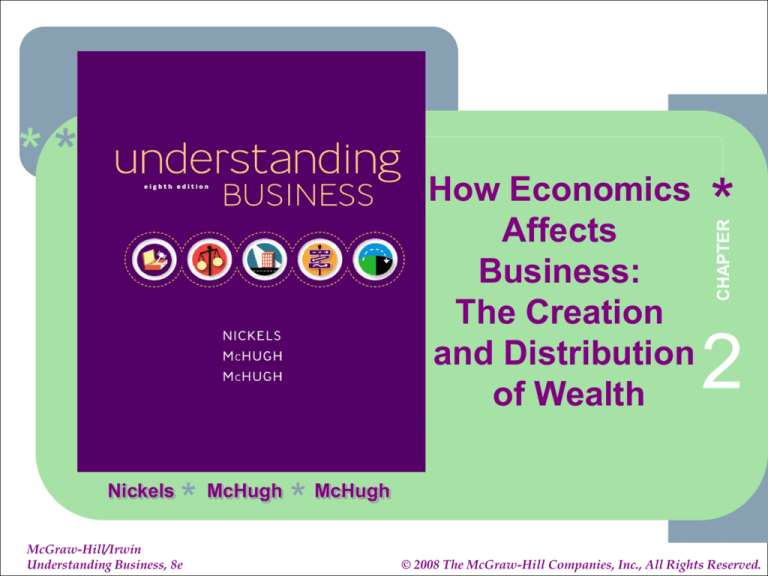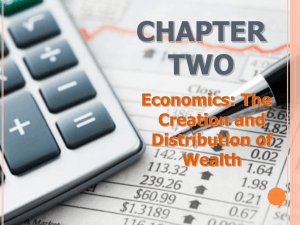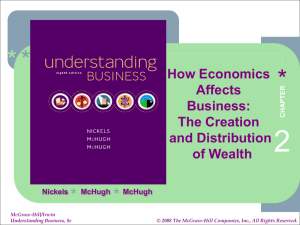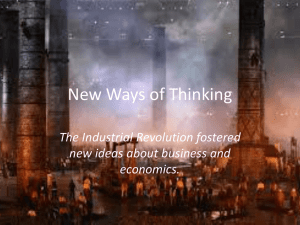
*
*
*
How Economics
Affects
Business:
The Creation
and Distribution
of Wealth
Nickels
*
McGraw-Hill/Irwin
Understanding Business, 8e
McHugh
*
*
CHAPTER
**
2
McHugh
1-1
2-1
© 2008 The McGraw-Hill Companies, Inc., All Rights Reserved.
*
*
*
Economics: Create Wealth
• Study of how society chooses to
employ resources to produce
goods & services and distribute
them among competing
groups/individuals
• Micro v. Macro
• Resource Development
2-2
*
*
*
Economics defined
ECONOMICS
is the study of how society chooses to employ
resources to produce goods and services and
distribute them for consumption among
various competing groups and individuals.
2-3
*
* How does Economics effect business
*
I. HOW ECONOMIC CONDITIONS AFFECT BUSINESSES
Learning Goal
1 Compare and contrast the economics of despair with the
economics of growth.
A. What Is Economics?
B. Why Economics Was Known as “the Dismal Science”
C. Growth Economics and Adam Smith
D. How Businesses Benefit the Community.
2-4
*
*
*
Business Cycles
20
PEAK
15
Prosperity
Decline
10
Expansion
5
Recession
TROUGH
0
Source: U.S. Bureu of Labor Statistics
T1
T2
T3
T4
T5
T6
T7
T8
T9
T10
2-5
*
*
*
Four “What’s” of
an Economic System
$ What is produced?
$ What amount is produced?
$ What is the method of output
distribution?
$ What is the rate of economic growth?
Adapted from: Edwin Mansfield Economics (New York: W.W. Norton, 1976), p.8
2-6
*
*
*
WHY ECONOMICS WAS KNOWN AS
“THE DISMAL SCIENCE”
The English economist Thomas Malthus believed that population
growth would outstrip resources.
In response, Thomas Carlyle called economics
“THE DISMAL SCIENCE.”
Many still believe, like Malthus, that the solution to poverty is
birth control.
WORLD POPULATION is currently growing more slowly than
expected.
But population in the developing world will continue to climb
quickly.
2-7
*
*
*
Economic Theories
•
Adam Smith (1776)
• Wrote one of the most important works on
Capitalism – Economics
• The Wealth of Nations
• Freedom is vital
• “Invisible Hand”
2-8
*
*
*
Economic Theories
•
Thomas Malthus (Early 1800s)
• Studied the impact of population growth
• “Dismal Science”
• Too many people
2-9
*
* How does Economics effect business
*
II. UNDERSTANDING FREE-MARKET CAPITALISM
Learning Goal 2
Explain what capitalism is and how free markets work.
A. The Foundations of Capitalism
B. How Free Markets Work
C. How Prices Are Determined
D. The Economic Concept of Supply
E. The Economic Concept of Demand
F. The Equilibrium Point, or Market Price
G. Competition within Free Markets
H. Benefits and Limitations of Free Markets
2-10
*
*
*
Circular Flow Model
2-11
*
*
*
Supply Curve
High
Price(P)
S
Low
Quantity(S)
High
2-12
*
*
*
Demand Curve
High
Price(P)
D
Low
Quantity(D)
High
2-13
*
*
*
Equilibrium Point
Surplus
High
Market Equilibrium
Price
S
Low
Shortage
Quantity
D
High
2-14
*
*
*
Understanding Competition
Economies describe competition as
Perfect
Monopoly
Oligoply
Monpolistic
2-15
*
*
*
Adam Smith
•
Wrote the Wealth of Nations
•
dam Smith (1776)
• Freedom is vital
• “Invisible Hand”
2-16
*
*
*
Free-Market Competition
Monopolistic
Oligopoly
Competition
One
Many
Perfect
Competition
Monopoly
Sellers
2-17
*
*
*
Competitive market conditions
•
How many Buyers?
•
How many Sellers?
•
What power or influence does the
seller have over the market ?
•
How similar are the products?
2-18
*
*
*
Perfect Competition
Sellers
Buyer
2-19
*
*
*
Perfect Competition
Unlimited number of
buyers and sellers
no one can influence the
market
2-20
*
*
*
Monopolistic Competition:
Many Sellers With Perceived Differences
•
Fast Food
•
Colleges
2-21
*
*
*
Oligopoly: Few Sellers
•
Automobiles
•
Tobacco
2-22
*
*
*
Monopoly: One Seller
•
Utilities
• Microsoft?
2-23
*
*
*
Limits of Free-Markets
•
Inequality of Wealth- Causes
National & World Tension
•
Greed Compromises Ethics
•
Limitations Push Country
towards Socialism =
Government Regulation
2-24
*
*
*
Understanding Market Structures
Economies are identified – classified as
Capitalism
Communism
Socialism
Mixed
2-25
*
*
*
Three Economic Systems
Mixed
Socialism
(Highly Controlled)
(Little Control)
Communism
Capitalism
2-26
*
*
*
Capitalism
•
Private Property
•
Business Ownership/ Profits
•
Freedom of Competition
•
Freedom of Choice
These are referred to as the “Rights of Capitalism”
2-27
*
* How does Economics effect business
*
•
III. UNDERSTANDING SOCIALISM
Learning Goal 3 Discuss the major differences between socialism
and communism..
A. The Benefits of Socialism
B. The Negative Consequences of Socialism
2-28
*
*
*
Socialism
•
Private & Public Ownership
•
Some Choices are Limited
• Creates Social Equality
• Reduces Individual Incentive
- Brain Drain
2-29
*
*
*
Industrialized Nations’
Top Individual Tax Rate
U.S.
Japan
Germany
Italy
Spain
France
Austria
Denmark
0%
10%
20%
30%
40%
50%
60%
70%
Source: www.worldwide-tax.com, May 9, 2006
2-30
*
*
*
Communism
•
Public Ownership
•
•
Almost all major factors of
production
Central Planning/Controlled
Economy
• Shortages of food and other products
may develop
• Lack of motivation to work hard for
business people
2-31
*
* What is the major difference between
* free markets and controlled markets
To what extent does government control
or regulate the economic activity
Minimum Wage
Taxes
Right to compete
Right to open a new business
2-32
*
* How does Economics effect business
*
V. THE TREND TOWARD MIXED ECONOMIES
Learning Goal 4
Explain the trend toward mixed economies.
2-33
*
*
*
Mixed Economies
•
Free-Market Economy = Capitalism
•
Command Economy
• Socialism
• Communism
•
Trend Results in Blend/Mix
• Capitalism > Socialism
• Socialism > Capitalism
2-34
* How does Economics effect business
*
* VI. UNDERSTANDING THE ECONOMIC SYSTEM OF THE UNITED
STATES
Learning Goal 5 Discuss the economic system of the United States,
including the significance of key economic indicators (especially
GDP), productivity, and the business cycle.
A. Key Economic Indicators
1. Gross Domestic Product
2. The Unemployment Rate
3. The Price Indexes
B. Productivity in the United States
C. Productivity in the Service Sector
D. The Business Cycle
E. Stabilizing the Economy through Fiscal Policy
Learning Goal 6 Define fiscal policy and monetary policy, and explain
how each affects the economy.
F. Using Monetary Policy to Keep the Economy Growing
2-35
*
*
*
Number of Workers per
Social Security Recipient
6
5
4
3
2
1
0
1960
2000
2075(Est.)
Source: Investors.com
2-36
*
*
*
Why is the U.S.
an Economic Success?
Major Reason
Percent*
Constitution
85
Free Elections
84
Free Enterprise System
81
Abundant Resources
78
Cultural Diversity
71
* Respondents could choose more than one.
Source: Investors Business Daily Survey
2-37
*
*
*
U.S. Economy
•
•
•
•
Key Economic Indicators
Productivity in the U.S.
Productivity in the Service Sector
Business Cycles
• Recession
• Depression
• Recovery
• Stabilization
• Fiscal Policy
• National Debt
• Economic Growth through Monetary Policy
2-38
*
*
*
Key Economic Indicators
•
Gross Domestic Product (GDP)
The sum of all goods and service produced in a
given period
Does not include used goods
Financial products (sale or purchase of securities
Or the value of domestic work performed by
housewives or house dads
2-39
*
*
*
Key Economic Indicators
Unemployment Rate
Made up of a couple of statistics
Labor force participation rate
Types of Unemployment
Structural, Cyclical
Discouraged worker effect
Full employment unemployment
2-40
*
*
*
Key Economic Indicators
Price Indexes
Consumer Price Index (CPI)
Producer Price Index (PPI)
2-41
*
*
*
U.S. Gross
Domestic Product
14,000
12,000
10,000
8,000
In Billions of U.S. $
6,000
4,000
2,000
0
1940
1950
Source: U.S. Dept. of Commerce, Bureau of Economic Analysis
1960
1970
1980
1990
2000
2002
2005
2-42
*
*
*
Share of World GDP(%)
1975
•G-8 Countries
•U.S. only
•China
•India
•Latin America
•Africa
Source: www.dlc.org/ppi, July 6, 2005
55
22
5
3
7
3
2004
44
21
13
6
6
3
*
*
*
U.S. Unemployment (%)
16
14
12
10
8
6
4
2
0
1940
1950
1960
1970
1980
1990
2000
2002
2005
Source: U.S. Bureau of Labor Statistics
Source: U.S. Bureau of Labor Statistics
2-44
*
*
*
What Makes Up The
Consumer Price Index?
Recreation Apparel
5%
6%
Medical Care/
Insurance
7%
Medical Care
6%
Other
5%
Housing & Util.
39%
Food &
Beverage
16%
Transportation
18%
Source: U.S. Bureau of Labor Statistics
2-45
*
*
*
Consumer Price Index
250
200
150
100
50
1982-84 = 100
0
1940
1950
1960
1970
1980
1990
2000
2002
Apr.
2006
Source: U.S. Dept. of Labor, Bureau of Labor Statistics
2-46
*
*
*
Percent Change in Labor
Productivity- U.S.
9
8
7
6
5
4
3
2
1
0
-1
1950
1960
1970
Source: U.S. Dept. of Commerce, Bureau of Labor Statistics
1980
1990
2000
2002
Q1 2006
2-47
*
*
*
Where Does the
Government Get Its Money?
4%
4%
9%
43%
Individual Income
Taxes
Social Security &
Payroll Taxes
Corporate Taxes
Excise Taxes
40%
Other
Source: Office of Management & Budget, 2002
2-48
*
*
*
Federal Spending
50%
45%
40%
35%
30%
25%
20%
15%
10%
5%
0%
1966
2006
Medicare &
Medicaid
Social
Security
Interest
Defense
Other
Source: Congressional Budget Office
2-49
*
*
*
Biggest Economic
Challenges
• Over the Next 3-5 years the U.S. can be
expected to face these challenges:
•
•
•
•
•
Pension & Health care costs
The Federal Deficit
High Energy and Commodity Costs
Balance of payments
Terrorism
Source: Investors Business Daily January 9, 2006
2-50
*
*
*
Health Expenditure Projections
(Percent of National GDP)
18.00%
17.50%
17.00%
16.50%
16.00%
15.50%
15.00%
14.50%
14.00%
2004
2006
2008
2010
2012
% of GDP
Source: FORTUNE May 3, 2004
2-51
*
*
*
Rising US Trade Deficit
0
-100000
-200000
-300000
Deficit in
Millions
-400000
-500000
-600000
-700000
-800000
1980 1985 1990 1995 1999 2001 2003 2005
Source: US Dept of Commerce, Bureau of Economic Analysis
2-52
*
*
*
Where are the Homeland
Security Dollars Spent?
14
12
10
8
6
4
2
0
Border & Port
Security
Aviation Security
Immigration
Enforcement
BioDefense
Infrastructure
Protection
Source: Business Week June 14, 2004
2-53
*
*
*
What is the National Debt?
• The debt has reached $8.36
trillion+ (May 2006)
• If $1,000 bills were stacked:
• $1 Million = 4.29 Inches
• $1 Billion = 357.5 Feet
• $1 Trillion =
67 Miles
• The debt is equal to 560.1 miles in
$1,000 bills
• National Debt Clockhttp://www.brillig.com/debt_clock/
2-54










